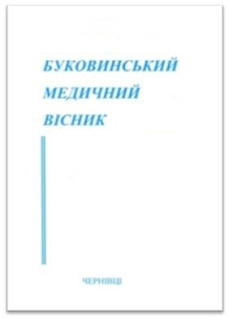Стан гена ранньої функціональної активності c-fos у суб’ядрах паравентрикулярного ядра гіпоталамуса щурів в умовах модифікацій фотоперіоду
DOI:
https://doi.org/10.24061/164735Ключові слова:
ген с-fos, імуноспецифічний білок c-Fos, паравентрикулярне ядро гіпоталамуса, постійне освітлення, світлова деприваціяАнотація
Досліджено вплив модифікацій нормальної фотоперіодики на стан гена ранньої функціональної активності c-fos у суб’ядрах паравентрикулярного ядра (ПВЯ) гіпоталамуса щурів у різні проміжки доби (вдень і вночі). Експресія продукту цього гена – білка c-Fos – у тварин, котрі утримувалися в нормальних умовах чергування освітлення та темряви, демонструвала досить чіткий циркадіанний характер. Водночас зміна тривалості циклу світло-темрява призводить до вираженого десинхронозу. Визначальними чинниками, які вплинули на індекс інтегральної щільності c-Fos у досліджуваних структурах ПВЯ гіпоталамуса щурів були зміни концентрації даного білка та індексу вмісту c-Fos у суб’ядрах нейронів.
Посилання
Anisimov VN. Melatonin: perspektivy primeneniya dlya profilaktiki raka i prezhdevremennogo stareniya [Melatonin: prospects for cancer prevention and premature aging]. Vestnik vosstanovitel'noy meditsiny. 2007;1:4-7. (in Russian).
Bondarenko LA, Gubina-Vakulik GI, Sotnik NN. Vliyanie postoyannogo osveshcheniya na sutochnyy ritm melatonina i strukturu pineal'noy zhelezy u krolikov [The effect of constant lighting on the daily rhythm of melatonin and the structure of the pineal glands in rabbits]. Problemy endokrinnoy patologii. 2005;4:38-5. (in Russian).
Gancheva OV. Lineynye otlichiya patternov ekspressii belka s-Fos v neyrosekretornykh yadrakh gipotalamusa u krys linii SHR i Wistar, kak patogeneticheskoe zveno formirovaniya geneticheski obuslovlennoy patologii [Linear differences in the patterns of c-Fos protein expression in the neurosecretory nuclei of the hypothalamus in SHR and Wistar rats, as a pathogenetic link in the formation of a genetically determined pathologies]. Klinichna ta eksperymental'na patolohiia. 2008;7(3):1-10. (in Russian).
Zamorskiy II, Pishak VP. Funktsional'naya organizatsiya fotoperiodicheskoy sistemy golovnogo mozga [Functional organization of the photoperiodic system of the brain]. Uspekhi fiziologicheskikh nauk. 2003;34(4):37-3. (in Russian).
Kolesnik YuM, Abramov AV, Zhulinskiy VA. Korrektsiya immunno-endokrinnykh narusheniy pri eksperimental'nom sakharnom diabete vvedeniem gipotalamicheskikh neyropeptidov [Correction of immune-endocrine disorders in experimental diabetes mellitus by administration of hypothalamic neuropeptides]. Klinichna ta eksperymental'na patolohiia. 2006;3(2):120-23. (in Russian).
Arendt J. Melatonin: characteristics, concerns, and prospects. J Biol Rhythms. 2005;20:291-3.
Ekmekcioglu C. Melatonin receptors in humans: biological role and clinical relevance. Biomed Pharmacother. 2006;60(3):97-8.
Ishikura T, Suzuki H, Yoshimura M. Expression of the c-fos-monomeric red fluorescent protein 1 fusion gene in the spinal cord and the hypothalamic paraventricular nucleus in transgenic rats after nociceptive stimulation. Brain Res. 2012;15(1479):52-1.
Hannibal О, Vrang N. Light-dependent induction of c-Fos during subjective day and night in PACAP-containing ganglion cells of the retinohypothalamic tract. J Biol Rhythms. 2001;16(5):457-70.
Bulyk RE, Vasilenko DA, Pishak VP. Neurons of the Paraventricular Hypothalamic Nucleus Under Normal and Modified Illumination Conditions: Immunohistochemical and Morphometric Parallels. Neurophysiology. 2012;44(1):26-2.
Reiter RJ, Tan DX, Madrid JA. When the circadian clock becomes a ticking time bomb. Chronobiol Int. 2012;29(9):1286-287.
##submission.downloads##
Опубліковано
Номер
Розділ
Ліцензія
Авторське право (c) 2019 O. V. Timofei, R. Ye. Bulyk

Ця робота ліцензованаІз Зазначенням Авторства 3.0 Міжнародна.
Автори залишають за собою право на авторство своєї роботи та передають журналу право першої публікації цієї роботи на умовах ліцензії Creative Commons Attribution License, котра дозволяє іншим особам вільно розповсюджувати опубліковану роботу з обов'язковим посиланням на авторів оригінальної роботи та першу публікацію роботи у цьому журналі.
Автори мають право укладати самостійні додаткові угоди щодо неексклюзивного розповсюдження роботи у тому вигляді, в якому вона була опублікована цим журналом (наприклад, розміщувати роботу в електронному сховищі установи або публікувати у складі монографії), за умови збереження посилання на першу публікацію роботи у цьому журналі.
Політика журналу дозволяє і заохочує розміщення авторами в мережі Інтернет (наприклад, у сховищах установ або на особистих веб-сайтах) рукопису роботи, як до подання цього рукопису до редакції, так і під час його редакційного опрацювання, оскільки це сприяє виникненню продуктивної наукової дискусії та позитивно позначається на оперативності та динаміці цитування опублікованої роботи (див. The Effect of Open Access).


